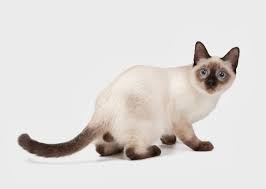Introduction
The Thai cat, also known as the Wichienmaat in Thailand and the Old-Style Siamese elsewhere, is a breed cherished for its unique features and rich history. This article delves into the breed’s origins, characteristics, personality, and distinct traits to provide a thorough understanding of this fascinating feline.
Historical Background
The Thai cat breed has a storied history, deeply rooted in Thailand’s culture for over 700 years. Originating from the ancient kingdom of Ayudhia, these cats were revered in Thai society and documented in the Cat Poems (Tamra Maew). In the 19th century, British citizens discovered these blue-eyed, colorpoint cats in Siam (now Thailand) and brought them to the West, where they were named “Siamese.”
Over time, Western breeders modified the breed to create a more striking appearance, resulting in the modern Siamese cat. However, by the 1950s, breeders who preferred the original, moderate type began to differentiate the Thai from the evolving Siamese. The World Cat Federation granted the breed championship status in 1990, renaming it the Thai to distinguish it from the contemporary Siamese.
Physical Characteristics
Thai cats are known for their moderate, balanced appearance. They possess a medium-boned, supple body, short and silky coat, and distinctive head shape. The head is round-cheeked with a flat forehead and a wedge-shaped muzzle. Their deep blue eyes and colorpoint pattern—dark extremities with a lighter body—are signature traits.
Key Features:
- Body: Medium-boned, lithe, and substantial
- Coat: Short, flat, and silky
- Head: Rounded cheeks with a flat forehead and wedge-shaped muzzle
- Eyes: Deep blue and almond-shaped
- Color: Colorpoint pattern with variations like seal, blue, chocolate, and lilac
Personality and Temperament
Thai cats are celebrated for their lively and engaging personalities. Highly intelligent and affectionate, they form strong bonds with their owners. These cats are known for their playful nature, often compared to living with small children due to their curiosity and activity levels. They enjoy being involved in their owners’ activities and are adept communicators, using both vocalizations and body language to express themselves.
Personality Traits:
- Intelligent and Curious: Enjoy mental stimulation and exploration
- Affectionate and Social: Form deep connections with their human companions
- Playful and Active: Require ample playtime and engagement
- Vocal: Communicative with a variety of sounds, though not necessarily loud
- Emotional Needs: Thrive on daily interaction and attention
Health and Care
Thai cats are generally healthy and easy to care for, thanks to their short coat that requires minimal grooming. However, their social nature means they need plenty of mental and physical stimulation. Providing interactive toys, climbing trees, and engaging in regular play sessions can keep them happy and healthy.
Care Tips:
- Grooming: Minimal grooming needed due to their short coat
- Diet: High-quality diet to maintain overall health
- Exercise: Regular play and mental stimulation to prevent boredom
- Vet Visits: Routine veterinary care to monitor health
Conclusion
The Thai cat breed is a perfect blend of historical charm and affectionate companionship. With their distinctive looks and engaging personalities, Thai cats make wonderful pets for those willing to provide the attention and interaction they crave. Whether admired for their ancient lineage or cherished for their modern companionship, Thai cats continue to enchant cat lovers around the world.
This comprehensive guide aims to highlight the unique qualities of the Thai cat breed, ensuring that potential and current owners are well-informed about their history, characteristics, and care needs.

